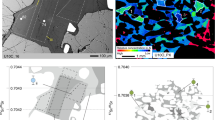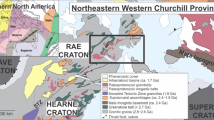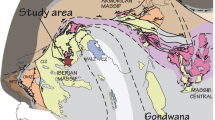Abstract
The petrology and timing of crustal melting has been investigated in the migmatites of the Higher Himalayan Crystalline (HHC) exposed in Sikkim, India. The metapelites underwent pervasive partial melting through hydrous as well as dehydration melting reactions involving muscovite and biotite to produce a main assemblage of quartz, K-feldspar, plagioclase, biotite, garnet ± sillimanite. Peak metamorphic conditions were 8–9 kbar and ~800 °C. Monazite and zircon crystals in several migmatites collected along a N–S transect show multiple growth domains. The domains were analyzed by microbeam techniques for age (SHRIMP) and trace element composition (LA-ICP-MS) to relate ages to conditions of formation. Monazite preserves the best record of metamorphism with domains that have different zoning pattern, composition and age. Zircon was generally less reactive than monazite, with metamorphic growth zones preserved in only a few samples. The growth of accessory minerals in the presence of melt was episodic in the interval between 31 and 17 Ma, but widespread and diachronous across samples. Systematic variations in the chemical composition of the dated mineral zones (HREE content and negative Eu anomaly) are related to the variation in garnet and K-feldspar abundances, respectively, and thus to metamorphic reactions and P–T stages. In turn, this allows prograde versus decompressional and retrograde melt production to be timed. A hierarchy of timescales characterizes melting which occurred over a period of ~15 Ma (31–17 Ma): a given block within this region traversed the field of melting in 5–7 Ma, whereas individual melting reactions lasted for time durations below, or approaching, the resolution of microbeam dating techniques (~0.6 Ma). An older ~36 Ma high-grade event is recorded in an allocthonous relict related to mafic lenses. We identify two sections of the HHC in Sikkim that traversed similar P–T conditions at different times, separated by a tectonic discontinuity. The higher structural levels reached melting and peak conditions later (~26–23 Ma) than the lower structural levels (~31–27 Ma). Diachronicity across the HHC cannot be reconciled with channel flow models in their simplest form, as it requires two similar high-grade sections to move independently during collision.









Similar content being viewed by others
References
Acharryya SK, Ray KK (1977) Geology of the Darjeeling-Sikkim Himalaya, guide to excursion no. 4, International Gondwana Symposium. Geological Survey of India, p 25
Aleinikoff JN, Schenck WS, Plank MO, Srogi L, Fanning CM, Kamo SL, Howell B (2006) Deciphering igneous and metamorphic events in high-grade rocks of the Wilmington Complex, Delaware: morphology, cathodoluminescence and backscattered electron zoning, and SHRIMP U-Pb geochronology of zircon and monazite. Geol Soc Am Bull 118(1/2):39–64
Bea F, Pereira MD, Stroh A (1994) Mineral/leucosome trace-element partitioning in a peraluminous migmatite (a laser ablation-ICP-MS study). Chem Geol 117:291–312
Beaumont C, Jamieson RA, Nguyen MH, Medvedev S (2004) Crustal channel flows: 1. Numerical models with applications to the tectonics of the Himalayan-Tibetan orogen. J Geophys Res 109:B06406. doi:10.1029/2003JB002809
Black LP, Kamo SL, Allen CM, Aleinikoff JM, Davis DW, Korsch RJ, Foudoulis C (2003) TEMORA 1: a new zircon standard for Phanerozoic U-Pb geochronology. Chem Geol 200:155–170
Buick IS, Clark C, Rubatto D, Hermann J, Pandit M, Hand M (2010) Constraints on the proterozoic evolution of the Aravalli-Delhi Orogenic belt (NW India) from monazite geochronology and mineral trace element geochemistry. Lithos (in press)
Butera KM, Williams IS, Blevin PL, Simpson CJ (2004) Zircon U-Pb dating of early palaeozoic monzonitic intrusives from the Goonumbla area, New South Wales. Aust J Earth Sci 48:457–464
Carosi R, Montomoli C, Rubatto D, Visona’ D (2010) Late oligocene high-temperature shear zones in the core of the Higher Himalayan crystallines (Lower Dolpo, western Nepal). Tectonics 29:TC4029. doi:10.1029/2008TC002400
Catlos EJ, Harrison TM, Manning CE, Grove M, Rai SM, Hubbard MS, Upreti BN (2002) Records of the evolution of the Himalayan orogen from in situ Th-Pb ion microprobe dating of monazite: Eastern Nepal and western Garhwal. J Asian Earth Sci 20(5):459–479
Catlos EJ, Dubey CS, Harrison TM, Edwards MA (2004) Late Miocene movement within the Himalayan Main Central Thrust shear zone, Sikkim, north-east India. J Metamorphic Geol 22:207–226
Cherniak DJ (2010) Diffusion in accessory minerals: zircon, titanite, apatite, monazite and xenotime. Rev Mineral Geochem 72:827–869
Corfu F, Hanchar JM, Hoskin PWO, Kinny P (2003) Atlas of zircon textures. In: Hanchar JM, Hoskin PWO (eds) Zircon, vol 53. Reviews in Mineralogy, 1st edn. Mineralogical Society of America, Washington DC, pp 469–500
Cottle JM, Jessup MJ, Newell DL, Horstwood MSA, Noble SR, Parrish RR, Waters DJ, Searle MP (2009a) Geochronology of granulitized eclogite from the Ama Drime Massif: implications for the tectonic evolution of the South Tibetan Himalaya. Tectonics 28(1):TC1002
Cottle JM, Searle MP, Horstwood M, Waters DJ (2009b) Midcrustal metamorphism, melting, and deformation in the Mount Everest region of Southern Tibet revealed by U(-Th)-Pb geochronology. J Geol 117(6):643–664. doi:10.1086/605994
Dasgupta S, Ganguly J, Neogi S (2004) Crystallization history, P-T gradient, and implications. J Metamorphic Geol 22:395–412. doi:10.1111/j.1525-1314.2004.00522.x
Dasgupta S, Chakraborty S, Neogi S (2009) Petrology of an inverted Barrovian sequence of metapelites in Sikkim Himalaya, India: constraints on the tectonic inversion. Am J Sci 309:43–84. doi:10.2475/01.2009.02
Eggins SM, Rudnick RL, McDonough WF (1998) The composition of peridotites and their minerals: a laser ablation ICP-MS study. Earth Planet Sci Lett 154:53–71
Faak K, Chakraborty S, Dasgupta S (2012) Petrology and tectonic significance of metabasic slivers in the lesser- and higher Himalayan sections of Sikkim, India. J Metamorphic Geol (in press)
Faccenda M, Gerya TV, Chakraborty S (2008) Styles of post-subduction collisional orogeny: influence of convergence velocity, crustal rheology and radiogenic heat production. Lithos 103(1–2):257–287
Fletcher IR, McNaughton NJ, Davis WJ, Rasmussen B (2010) Matrix effects and calibration limitations in ion probe U-Pb and Th–Pb dating of monazite. Chem Geol 270:31–44
Foster G, Kinny P, Vance D, Prince C, Harris N (2000) The significance of monazite U-Th-Pb age data in metamorphic assemblages; a combined study of monazite and garnet chronometry. Earth Planet Sci Lett 181(3):327–340
Foster G, Gibson HD, Parrish RR, Horstwood M, Fraser J, Tindle A (2002) Textural, chemical and isotopic insight into the nature and behaviour of metamorphic monazite. Chem Geol 191(1–3):183–207
Ganguly J, Dasgupta S, Cheng W, Neogi S (2000) Exhumation history of a section of the Sikkim Himalayas, India: records in the metamorphic mineral equilibria and compositional zoning of garnet. Earth Planet Sci Lett 183:471–486
Ghosh A (1956) Recent advances in the geology and structure of the eastern Himalaya. Indian Sci Congr 44:85–99
Godin L, Parrish RR, Brown RL, Hodges KV (2001) Crustal thickening leading to exhumation of the Himalayan metamorphic core of Central Nepal: insight from U-Pb geochronology and 40Ar/39Ar thermochronology. Tectonics 20(5):729–747
Godin L, Grujic D, Law RD, Searle MP (2006) Channel flow, ductile extrusion and exhumation in continental collision zones: an introduction. In: Law RD, Searle MP, Godin L (eds) Channel flow, ductile extrusion and exhumation in continental collision zones, vol 268. Geological Society, London, Special Publications, pp 1–23
Groppo C, Rubatto D, Rolfo F, Lombardo B (2010) Early Oligocene partial melting in the main central thrust zone (Arun Valley, Eastern Nepal, Himalaya). Lithos 118:287–301
Grujic D, Warren CJ, Wooden JL (2011) Rapid synconvergent exhumation of Miocene-aged lower orogenic crust in the eastern Himalaya. Lithosphere 3(5):346–366
Harris NBW, Caddick M, Kosler J, Goswami S, Vance D, Tindle AG (2004) The pressure-temperature-time path of migmatites from the Sikkim Himalaya. J Metamorphic Geol 22(3):249–264
Harrison TM, Ryerson FJ, Le Fort P, Yin A, Lovera OM, Catlos EJ (1997) A late miocene-pliocene origin for the Central Himalayan inverted metamorphism. Earth Planet Sci Lett 146(1–2):E1–E7
Hermann J, Rubatto D (2003) Relating zircon and monazite domains to garnet growth zones: age and duration of granulite facies metamorphism in the Val Malenco lower crust. J Metamorphic Geol 21:833–852
Hermann J, Rubatto D, Trommsdorff V (2006) Sub-solidus oligocene zircon formation in garnet peridotite during fast decompression and fluid infiltration (Duria, Central Alps). Mineral Petrol 88:181–206
Holland TJB, Powell R (2001) Calculation of phase relations involving haplogranitic melts using an internally consistent thermodynamic dataset. J Petrol 42:673–683
Hoskin PWO, Black LP (2000) Metamorphic zircon formation by solid-state recrystallization of protolith igneous zircon. J Metamorphic Geol 18:423–439
Imayama T, Takeshita T, Yi K, Cho D-L, Kitajima K, Tsutsumi Y, Kayama M, Nishido H, Okumura T, Yagi K, Itaya T, Sano Y (2012) Two-stage partial melting and contrasting cooling history within the Higher Himalayan Crystalline Sequence in the far-eastern Nepal Himalaya. Lithos 134:1–22. doi:10.1016/j.lithos.2011.12.004
Jamieson RA, Beaumont C, Medvedev S, Nguyen MH (2004) Crustal channel flows: 2. Numerical models with implications for metamorphism in the Himalayan-Tibetan orogen. J Geophys Res B: Solid Earth 109:B06407:1–B06407:24. doi:10.1029/2003JB002811
Janots E, Engi M, Berger A, Allaz J, Schwarz JO, Spandler C (2008) Prograde metamorphic sequence of REE minerals in pelitic rocks of the Central Alps: implications for allanite-monazite-xenotime phase relations from 250 to 610∞C. J Metamorphic Geol 26(5):509–526
Jessup MJ, Cottle JM, Searle MP, Law RD, Newell DL, Tracy RJ, Waters DJ (2008) P-T-t-D paths of Everest series schist, Nepal. J Metamorphic Geol 26(7):717–740
Kellett DA, Grujic D, Warren C, Cottle J, Jamieson R, Tenzin T (2010) Metamorphic history of a syn-convergent orogen-parallel detachment: the South Tibet detachment, Buthan Himalaya. J Metamorphic Geol 28(8):785–808. doi:10.1111/j.1525-1314.2010.00893.x
Kelsey DE, Clark C, Hand M (2008) Thermobarometric modelling of zircon and monazite growth in melt-bearing systems: examples using model metapelitic and metapsammitic granulites. J Metamorphic Geol 26(2):199–212
Kohn MJ, Corrie SL (2012) Preserved Zr-temperatures and U–Pb ages in high-grade metamorphic titanite: evidence for a static hot channel in the Himalayan orogen. Earth Planet Sci Lett (in press)
Kohn MJ, Wieland MS, Parkinson CD, Upreti BN (2005) Five generations of monazite in Langtang gneisses: implications for chronology of the Himalayan metamorphic core. J Metamorphic Geol 23:399–406. doi:10.1111/j.1525-1314.2005.00584.x
Kretz R (1983) Symbols for rock-forming minerals. Am Mineral 68:277–279
Lal RK, Mukherji S, Ackermand D (1981) Deformation and Barrovian metamorphismat Takdah, Darjeeling (eastern Sikkim). In: Saklani PS (ed) Metamorphic tectonics of the Himalaya. Today and Tomorrow Publishers, Delhi, pp 231–278
Liu R, Zhou H, Zhang L, Zhong Z, Zeng W, Xiang H, Jin S, Lu X, Li C (2010) Zircon U-Pb ages and Hf isotope compositions of the Mayuan migmatite complex, NW Fujian Province, Southeast China: constraints on the timing and nature of a regional tectonothermal event associated with the Caledonian orogeny. Lithos 119(3–4):163–180
Ludwig KR (2003) Isoplot/Ex version 3.0. A geochronological toolkit for Microsoft Excel. Berkeley Geochronological Centre Spec. Pub., Berkeley
Martin AJ, Gehrels GE, DeCelles PG (2007) The tectonic significance of (U, Th)/Pb ages of monazite inclusions in garnet from the Himalaya of central Nepal. Chem Geol 244:1–24
Martin AJ, Ganguly J, DeCelles PG (2010) Metamorphism of greater and lesser himalayan rocks exposed in the Modi Khola valley, central Nepal. Contrib Mineral Petrol 159(2):203–223
McDonough WF, Sun S (1995) The composition of the earth. Chem Geol 120:223–253
Oliver NHS, Bodorkos S, Nemchin AA, Kinny PD, Watt GR (1999) Relationships between zircon U-Pb SHRIMP ages and leucosome type in migmatites of the Halls Creek Orogen, Western Australia. J Petrol 40(10):1553–1575
Pyle JM, Spear FS (2003) Four generations of accessory-phase growth in low-pressure migmatites from SW New Hampshire. Am Mineral 88(2–3):338–351
Ray SK (2000) Culmination zones in eastern Himalaya. Geological Survey of India Special publication, vol 55
Rubatto D (2002) Zircon trace element geochemistry: distribution coefficients and the link between U-Pb ages and metamorphism. Chem Geol 184:123–138
Rubatto D, Gebauer D (2000) Use of cathodoluminescence for U-Pb zircon dating by ion microprobe: some examples from the Western Alps. In: Pagel M, Barbin V, Blanc P, Ohnenstetter D (eds) Cathodoluminescence in geosciences. Springer, Berlin, pp 373–400
Rubatto D, Williams IS, Buick IS (2001) Zircon and monazite response to prograde metamorphism in the Reynolds Range, central Australia. Contrib Mineral Petrol 140:458–468
Rubatto D, Hermann J, Buick IS (2006) Temperature and bulk composition control on the growth of monazite and zircon during low-pressure anatexis (Mount Stafford, central Australia). J Petrol 47(10):1973–1996
Rubatto D, Müntener O, Barnhorn A, Gregory C (2008) Dissolution-reprecipitation of zircon at low-temperature, high-pressure conditions (Lanzo Massif, Italy). Am Mineral 93:1519–1529
Rubatto D, Hermann J, Berger A, Engi M (2009) Protracted fluid-induced melting during Barrovian metamorphism in the Central Alps. Contrib Mineral Petrol 158:703–722. doi:10.1007/s00410-009-0406-5
Schaltegger U, Fanning M, Günther D, Maurin JC, Schulmann K, Gebauer D (1999) Growth, annealing and recrystallization of zircon and preservation of monazite in high-grade metamorphism: conventional and in situ U-Pb isotope, cathodoluminescence and microchemical evidence. Contrib Mineral Petrol 134:186–201
Schärer U (1984) The effect of initial 230Th disequilibrium on young U-Pb ages: the Makalu case, Himalaya. Earth Planet Sci Lett 67:191–204
Simpson RL, Parrish RR, Searle MP, Waters DJ (2000) Two episodes of monazite crystallization during metamorphism and crustal melting in the Everest region of the Nepalese Himalaya. Geology 28(5):403–406
Spear FS (2010) Monazite–allanite phase relations in metapelites. Chem Geol 279:55–62
Spear FS, Pyle JM (2002) Apatite, monazite, and xenotime in Metamorphic Rocks. In: Kohn MJ, Rakovan J, Hughes JM (eds) Phosphates: geochemical, geobiological, and materials importance vol 48. Reviews in Mineralogy and Geochemistry Mineralogical Society of America, Washington DC, pp 293–335
Spear FS, Kohn MJ, Cheney JT (1999) P –T paths from anatectic pelites. Contrib Mineral Petrol 134:17–32
Stacey JS, Kramers JD (1975) Approximation of terrestrial lead evolution by a two-stage model. Earth Planet Sci Lett 26:207–221
Stepanov AS, Hermann J, Rubatto D, Rapp RP (2012) Experimental study of monazite/melt partitioning with implications for the REE, Th and U geochemistry of crustal rocks. Chem Geol 300–301:200–220
Tomaschek F, Kennedy AK, Villa IM, Lagos M, Ballhaus C (2003) Zircons from Syros, Cyclades, Greece—recrystallization and mobilization of zircon during high-pressure metamorphism. J Petrol 44:1977–2002
Townsend KJ, Miller CF, D’Andrea JL, Ayers JC, Harrison TM, Coath CD (2000) Low temperature replacement of monazite in the Ireteba granite, Southern Nevada: geochronological implications. Chem Geol 172:95–112
Vance D, Harris N (1999) Timing of prograde metamorphism in the Zanskar Himalaya. Geology 27(5):395–398
Vavra G, Schmidt R, Gebauer D (1999) Internal morphology, habit and U-Th-Pb microanalysis of amphibolite-to-granulite facies zircons: geochronology of the Ivrea Zone (Southern Alps). Contrib Mineral Petrol 134:380–404
Viskupic K, Hodges KV, Bowring SA (2005) Timescales of melt generation and the thermal evolution of the Himalayan metamorphic core, Everest region, eastern Nepal. Contrib Mineral Petrol 149(1):1–21
Warren C, Grujic D, Kellett DA, Cottle J, Jamieson R, Ghalley KS (2011) Probing the depth of the Indian-Asia collision: U-Th-Pb monazite chronology of granulites from NW Buthan. Tectonics 30:1–24. doi:10.1029/2010TC002738
Watson EB, Wark DA, Thomas JB (2006) Crystallization thermometers for zircon and rutile. Contrib Mineral Petrol 151:413–433
White RW, Powell R, Clarke GL (2003) Prograde metamorphic assemblage evolution during partial melting of metasedimentary rocks at low pressures: migmatites from Mt Stafford, Central Australia. J Metamorphic Geol 44(11):1937–1960
Williams IS (1998) U-Th-Pb geochronology by ion microprobe. In: McKibben MA, Shanks III WC, Ridley WI (eds) Application of microanalytical techniques to understanding mineralizing processes, vol 7. Reviews in Economic Geology, Society of Economic Geologists, pp 1–35
Williams IS (2001) Response of detrital zircon and monazite, and their U-Pb isotopic systems, to regional metamorphism and host-rock partial melting, Cooma Complex, southeastern Australia. Aust J Earth Sci 48:557–580
Williams ML, Jercinovic MJ, Harlov DE, Budzyn B, Hetherington CJ (2011) Resetting monazite ages during fluid-related alteration. Chem Geol 283:218–225
Wing BN, Ferry JM, Harrison TM (2003) Prograde destruction and formation of monazite and allanite during contact and regional metamorphism of pelites: petrology and geochronology. Contrib Mineral Petrol 145(2):228–250
Acknowledgments
Field work in Sikkim and data interpretation benefited from constructive and animated discussions with Robert Anczkiewicz and Dilip Mukhopadhyay. Michaela Flanigan and Mike Jolland (ANU) are thanked for compiling chemical data and petrographic observations, respectively. The review of C Warren and B Bingen is kindly acknowledged. D Rubatto was financially supported by the Australian Research Council, QEII fellowships, DP0556700 and DP110101599. The research of S Chakraborty is supported by funds from the DFG and the Ruhr Universitaet Bochum. S Dasgupta acknowledges the financial support of the DST, Government of India, through the J.C. Bose Fellowship.
Author information
Authors and Affiliations
Corresponding author
Additional information
Communicated by J. Hoefs.
Electronic supplementary material
Below is the link to the electronic supplementary material.
410_2012_812_MOESM6_ESM.eps
Probability diagrams with superimposed histograms of monazite U–Pb ages (left) and Tera-Wasserburg diagrams for monazite U–Pb analyses (right). Ellipses in the Tera-Wasserburg diagrams represent 2 sigma errors. Only filled gray ellipses are used for average age calculation. See text for details (EPS 3677 kb)
410_2012_812_MOESM7_ESM.eps
Probability diagrams with superimposed histograms of monazite U–Pb ages (left) and Tera-Wasserburg diagrams for monazite U–Pb analyses (right). Ellipses in the Tera-Wasserburg diagrams represent 2 sigma errors. Only filled gray ellipses are used for average age calculation. See text for details (EPS 2935 kb)
410_2012_812_MOESM8_ESM.eps
Probability diagrams with superimposed histograms of zircon U–Pb ages (left) and Tera-Wasserburg diagrams for zircon U–Pb analyses (right). Ellipses in the Tera-Wasserburg diagrams represent 2 sigma errors. Only filled gray ellipses are used for average age calculation. See text for details (EPS 2807 kb)
410_2012_812_MOESM9_ESM.eps
Ti-in-zircon temperatures plotted against average age of dated domains. Gray bars illustrate the spread of temperatures obtained from multiple domains of identical age. Black circles indicate the average temperature for each group. Thin lines link zircon domains from the same sample (EPS 328 kb)
Rights and permissions
About this article
Cite this article
Rubatto, D., Chakraborty, S. & Dasgupta, S. Timescales of crustal melting in the Higher Himalayan Crystallines (Sikkim, Eastern Himalaya) inferred from trace element-constrained monazite and zircon chronology. Contrib Mineral Petrol 165, 349–372 (2013). https://doi.org/10.1007/s00410-012-0812-y
Received:
Accepted:
Published:
Issue Date:
DOI: https://doi.org/10.1007/s00410-012-0812-y




